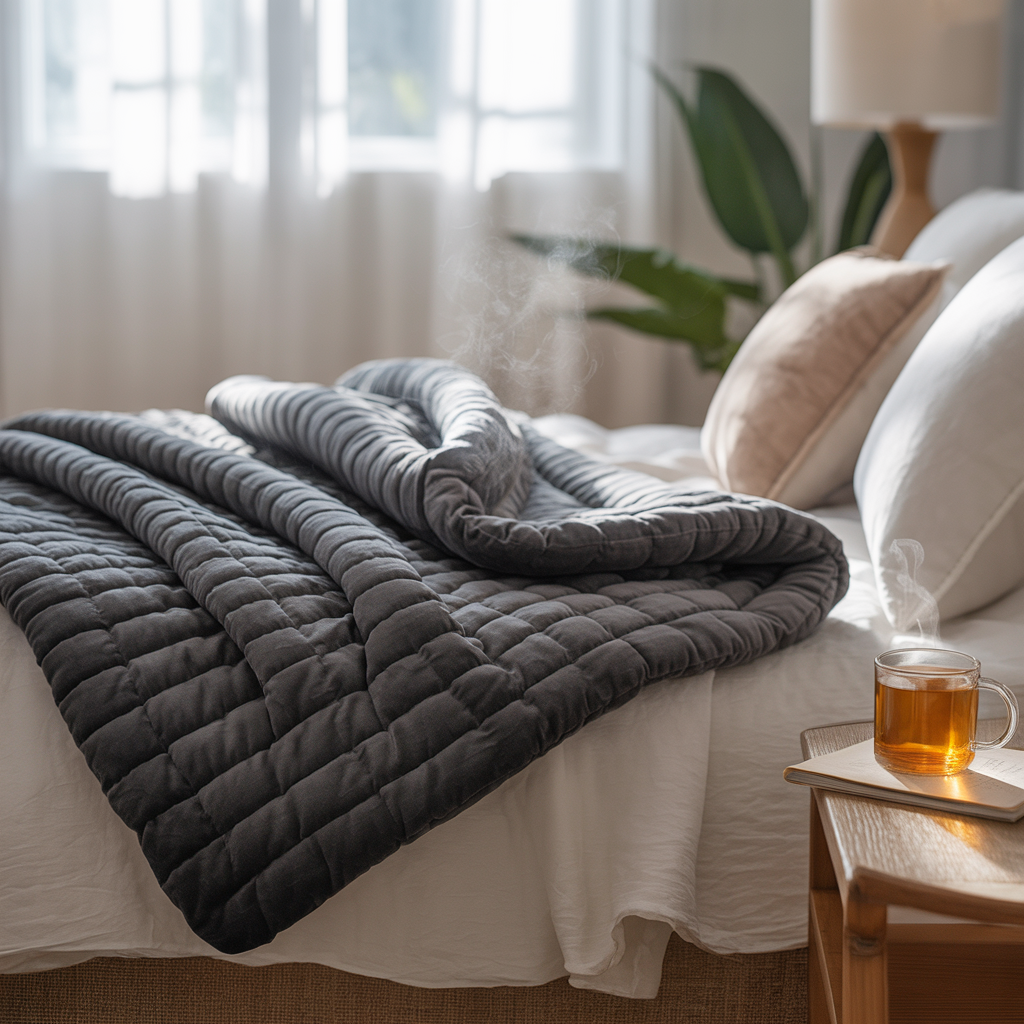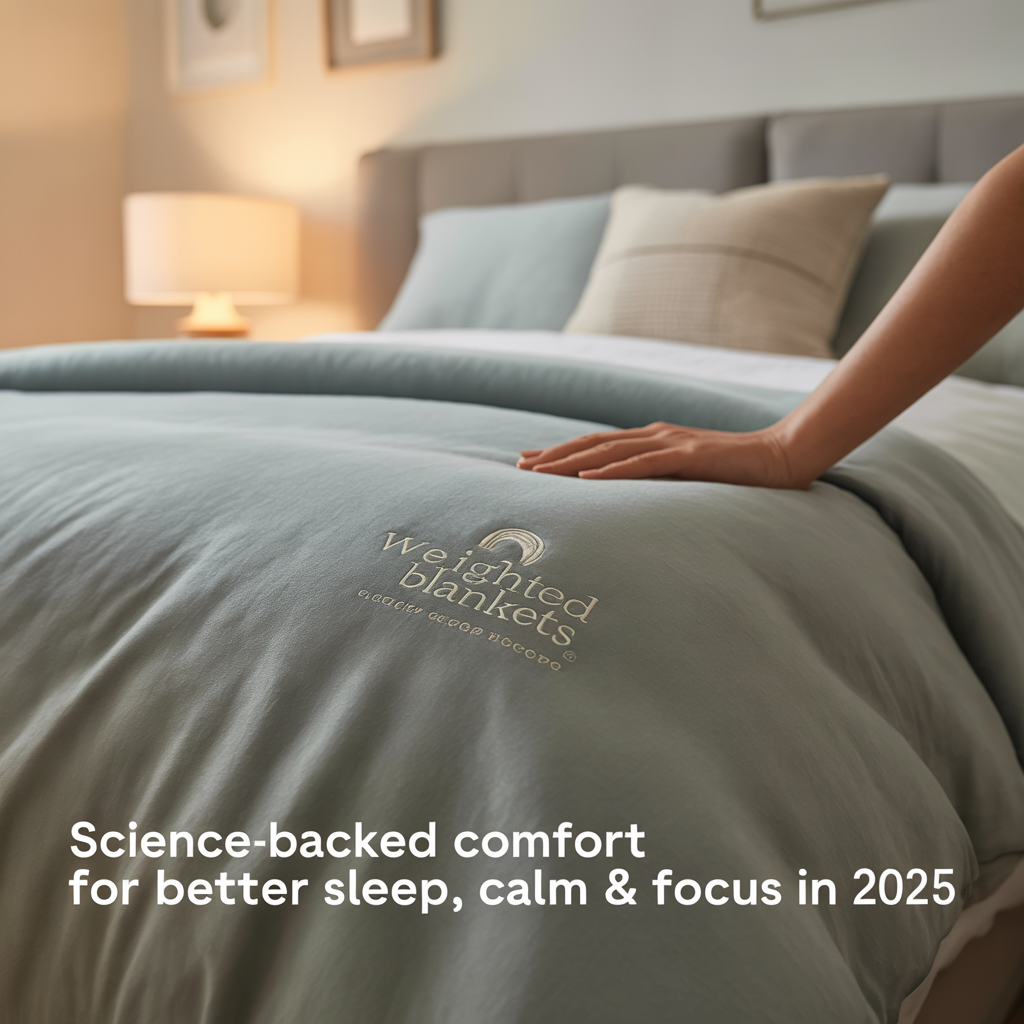
Six months ago, I found myself draped in what felt like a thick, gentle hug—my first encounter with a weighted blanket. I’d written off the trend, dismissing it as just another wellness fad until nocturnal anxiety and relentless tossing convinced me to try. To my surprise, it was less like a heavy quilt and more like an anchor, gently pulling my nerves down into stillness. As the science around deep touch pressure therapy grows and sleep-tech evolves, weighted blankets have become champions of calm for sleep-seekers, kids on the spectrum, and busy minds through 2025. But are they worth the hype? Let’s dig into both the data and delight, debunking buzz and sharing a few unexpected truths, because comfort—literal and figurative—has never mattered more.
What Weighted Blankets Really Feel Like: Beyond the Science
When I first slipped under a weighted blanket, I wasn’t prepared for the immediate shift in my nervous system. It wasn’t dramatic—no sudden wave of drowsiness or magical transformation. Instead, it was subtle, like someone had gently placed a reassuring hand on my shoulder and said, “It’s okay to let go now.”
The weighted blanket calming effect begins the moment that evenly distributed pressure settles across your body. Those tiny glass beads or polyfill materials aren’t just adding weight—they’re creating what researchers call deep touch pressure therapy, a gentle embrace that speaks directly to your nervous system in its own language.
The Science Made Simple: Your Body’s Natural Relaxation Switch
Deep pressure stimulation works like a master key for your body’s calm-down mechanisms. When that gentle, even weight presses against your skin, it triggers pressure receptors that send signals straight to your brain. These aren’t just any signals—they’re telling your nervous system to shift from fight-or-flight mode into rest-and-digest territory.
What happens next is fascinating. Research shows that this pressure stimulation prompts your brain to increase production of serotonin and melatonin—your body’s natural mood stabilizers and sleep promoters. Meanwhile, cortisol levels drop, taking that racing heartbeat and scattered thoughts down with them.
‘The gentle, even pressure of a weighted blanket can activate the body’s natural relaxation response.’ – Dr. Raj Dasgupta
I’ve experienced this firsthand during those nights when my mind refuses to quiet down. The moment I pull my weighted blanket up to my chin, there’s an almost immediate softening. My shoulders drop. My breathing deepens. Those chaotic thoughts that were ping-ponging around my head suddenly have less room to bounce.
Beyond Sleep: The Unexpected Comfort of Consistent Pressure
The weighted blankets for sleep benefits extend far beyond just falling asleep faster. During the day, when anxiety creeps in or sensory overload threatens to overwhelm, that same deep touch pressure becomes an anchor. It’s like having a constant, gentle reminder that you’re safe and grounded.
For parents I’ve spoken with who have children with sensory processing needs, the transformation is often remarkable. One described watching her son go from restless and agitated to calm and focused within minutes of using his weighted blanket during homework time.
The beauty of weighted blanket benefits lies in their simplicity. There’s no complicated protocol, no side effects to monitor. Just consistent, therapeutic pressure that works with your body’s existing systems to promote calm and better sleep quality.
What strikes me most is how this gentle weight creates a cocoon of security that feels both protective and liberating. It’s permission to stop fighting the day’s stress and simply be present in your own skin, wrapped in therapeutic comfort that your nervous system recognizes as safety.

Weighted Blanket Benefits: Real World Relief or Trendy Placebo?
I’ll be honest—when I first heard about weighted blankets, I was skeptical. Another wellness trend promising miraculous results? But after digging into the research and witnessing real-world transformations, I’ve come to understand that the benefits of weighted blankets extend far beyond trendy marketing claims.
The Sleep Quality Revolution
Let’s start with what matters most: sleep. Research shows that weighted blankets help regulate the autonomic nervous system, genuinely improving sleep quality and reducing those frustrating midnight awakenings. The gentle pressure—typically 8-10% of your body weight (so a 150-pound person would use a 15-pound blanket)—activates your parasympathetic nervous system. This isn’t just comfort; it’s science-backed sleep optimization.
I’ve seen this firsthand. My neighbor’s son, who has ADHD, uses his weighted blanket after school to self-soothe. It’s like watching him flip a ‘calm switch’—the transformation from restless energy to peaceful focus happens within minutes.
Anxiety Relief That Actually Works
Weighted blankets for anxiety aren’t just feel-good tools. They trigger the release of serotonin and melatonin while reducing cortisol—your stress hormone. For anxiety-prone adults, this gentle pressure therapy provides genuine relief without pharmaceutical intervention.
What impressed me most is how these anxiety relief blankets work even for skeptical minds. The deep pressure stimulation mimics the therapeutic technique used in occupational therapy, creating a sensation of safety and security that your nervous system recognizes and responds to.
Supporting Neurodiverse Needs
Weighted blankets for children with autism, ADHD, or sensory processing challenges offer particular benefits. The consistent pressure helps regulate sensory input, reducing overwhelm and supporting better self-regulation. However, pediatrician approval and gentle acclimatization are essential for young users.
‘For many individuals with anxiety or sensory processing challenges, a weighted blanket is more than comfort—it’s empowerment.’ – Dr. Temple Grandin
This empowerment extends to adults too. People with restless leg syndrome find relief from the consistent pressure, while those with PTSD report feeling safer and more grounded during sleep.
The 2025 Advantage
The best weighted blankets 2025 has to offer aren’t just heavier versions of regular bedding. They feature breathable covers for temperature regulation, body weight-specific options for optimal effectiveness, and eco-friendly designs that align with wellness-conscious values.
Modern designs address common concerns like overheating and difficult maintenance, making weighted blanket sleep quality improvements accessible to hot sleepers and busy households alike.
The evidence is clear: weighted blankets provide measurable benefits for sleep disruption, anxiety reduction, and sensory support. They’re not miracle cures, but they’re far from placebo effects. For many users, they represent a genuine pathway to better rest and reduced stress—no prescription required.

Shopping Smart: Picking the Weighted Blanket That’s Actually Right for You
Here’s the truth about how heavy should weighted blanket be and choosing the right one: blanket shopping is like dating—comfort is personal, so you need to test a few “personalities” before settling down. I’ve learned this the hard way after years of helping people find their perfect sleep companion.
The Weight Game: Getting the Numbers Right
The golden rule remains 8-10% of your body weight, but one size absolutely does not fit all. For adults, we’re typically looking at 12-25 pounds, while kids need something lighter at 5-10 pounds. I’ve seen too many people grab a 20-pound blanket thinking “heavier equals better,” only to feel trapped rather than comforted.
Research shows that correct weight and fabric choice maximize health benefits—don’t skip this step. Your nervous system responds differently to pressure that’s too light versus too heavy.
Deciphering Your Options: Materials Matter
Let me break down what you’re really choosing between:
- Glass beads vs. poly pellets: Glass beads distribute weight more evenly and stay quieter when you move. Poly pellets are budget-friendly but can feel lumpy over time.
- Cotton vs. bamboo fabric: Cotton breathes well, but bamboo and cotton fabric options are preferred for hot sleepers in 2025. Bamboo naturally wicks moisture and stays cooler.
- Size considerations: Twin works for solo sleepers, but couples often prefer separate blankets rather than sharing a king-size weighted one.
Hot Sleeper Considerations and Breathability
If you’re someone who kicks off covers at night, cooling weighted blankets have become game-changers. Fabric options impact breathability and climate comfort—bamboo and cotton are trending for coolness in 2025. Organic and sustainable options are emerging as favorites, offering both comfort and environmental peace of mind.
Essential Features to Watch
When evaluating the best weighted blankets 2025, I focus on practical features:
- Removable, washable covers (trust me, you’ll want this)
- Certifications like Oeko-Tex or organic materials
- Easy maintenance and durability
- Safety features, especially for kids
My Top Picks for Different Needs
Based on weighted blanket features and pricing, here’s what I recommend:
- Gravity Blanket: Premium microfleece option for anxiety relief
- YnM Bamboo: Best cooling option for hot sleepers
- Luna: Eco-certified and budget-friendly
- ZonLi: Washable design perfect for families
- Weighted Evolution Kids: Child-safe options (5-10 lbs)
“A perfect weighted blanket isn’t about the fanciest features—it’s about what feels like home.” – Dr. Michael Breus
For organic weighted blankets, Luna and several newer brands are leading the sustainable sleep movement. The key is matching your specific sleep style with the right combination of weight, fabric, and features—not just grabbing the most popular option.

A Few Sensible Words on Safety: When a Blanket Might Not Be the Answer
Before you dive headfirst into the world of weighted blankets, let me share some crucial safety insights that could make all the difference. While research shows these therapeutic tools are generally safe for most people, are weighted blankets safe for everyone? The honest answer is no—and that’s something we need to talk about openly.
The most critical weighted blanket safety concern involves our youngest family members. Children under 3 years old should absolutely never use weighted blankets due to suffocation risk. Their small bodies and developing motor skills make it difficult to move or remove a heavy blanket if breathing becomes compromised. This isn’t just overcautious advice—it’s a non-negotiable safety standard that pediatricians universally support.
For adults, the safety landscape looks different but still requires attention. If you have circulation issues, breathing problems, or are pregnant, you’ll want to consult your doctor before using a weighted blanket. These conditions can make the deep pressure stimulation problematic rather than beneficial. I’ve seen people assume that because weighted blankets help with anxiety, they’re automatically safe for everyone—but that’s simply not the case.
‘Safety first—your experience should be soothing, never stifling.’ – Dr. Whitney Roban
When it comes to weighted blanket weight guidelines, the general rule of 10% of your body weight isn’t just about comfort—it’s about safety too. Going beyond 35 pounds for most adults can create more restriction than relaxation. I always tell people to start lighter than they think they need. You can always upgrade to a heavier blanket, but you can’t undo the discomfort of choosing too much weight initially.
The potential risks of weighted blankets extend beyond weight considerations. Never cover your face with any weighted blanket, and always ensure you can easily remove it during the night. Some people experience claustrophobia or feel trapped, especially when first adjusting to the sensation. That’s why I recommend starting with short naps rather than full nights of sleep.
For children who are old enough to use weighted blankets safely, pediatrician input becomes essential. Every child with special medical needs, sensory processing challenges, or developmental concerns requires individualized assessment. What works wonderfully for one child might pose risks for another with similar conditions.
Here’s something most people don’t consider: if you ever feel restricted, overheated, or uncomfortable, that’s your body telling you something important. Major risks are rare but should always be assessed, especially in young children or those with special medical needs. The goal is therapeutic comfort, not endurance.
My approach is simple—ease into weighted blanket use gradually. Start with 20-30 minute sessions during relaxation time, then progress to naps, and finally to overnight use if everything feels right. Monitor your response closely, and don’t hesitate to adjust weight, duration, or discontinue use if needed.
Remember, weighted blankets should enhance your sleep and calm, never compromise your safety or comfort. When used appropriately and with proper precautions, they remain one of the most effective natural tools for better rest and reduced anxiety.
TL;DR: Weighted blankets offer more than cozy nights. By blending evidence-based benefits with real-world comfort, they help reduce anxiety, support focus, and enhance sleep quality—making them a must-consider tool for modern stress. Shop smart, use safely, and embrace your new nightly ritual for calm in 2025 and beyond.


